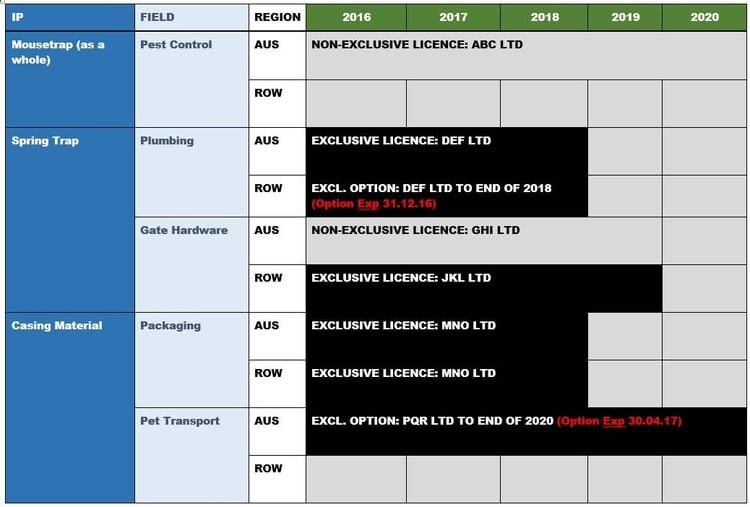When new IP is created, the desire to get it ‘out there’ is understandable. This is particularly so where the IP requires further development, has commercial potential, or originates from a researcher with a public benefit mandate. In the eagerness to license the IP, it is important to ensure that for all licences to rights granted, the IP owner has the rights to grant the licence.
The creation of innovative IP involves a great deal of time and money, investment which needs to be recouped in some way – whether to satisfy shareholders, enable further research work to continue, or attract additional grant funding.
It is therefore important to ensure that all aspects of each item of IP are fully exploited, often involving the grant of rights to different third parties across various sectors, fields and territories.
Of course, prior to disclosing the IP, there are a number of issues to be dealt with to ensure that the rights to the IP are properly protected. This article considers one of the key challenges that may be faced once that IP protection phase has been completed.
It may seem like an obvious point but an IP rights holder can only grant licences to rights that it holds and continues to hold.
As a firm, FAL is routinely instructed to review IP licensing documentation to advise clients on the extent of the rights granted. The motivation for such a review is usually to determine whether the client is free to grant further rights. Possibly, there may be a niggling concern in the back of the mind that the client may have already granted – or pledged to grant – the same exclusive rights to two parties.
After all, it is not just current rights that need to be taken into account here but also any rights that are the subject of an option. It is not outside the realms of possibility that a rights holder may (however inadvertently) grant exclusive rights to IP to one party when those same rights are still under option to another party. In that situation, all the IP owner may be able to readily do is keep their fingers crossed that the option is not exercised.
So, the lesson seems to be clear, keep a tight rein on the IP rights you grant to third parties. Simple, isn’t it?
Perhaps – where a rights holder owns limited items of IP applicable to few sectors, or has a team of IP managers. Not so straightforward where each item of IP in a rights holder’s IP portfolio is itself the subject of a number of licences, or where it is not possible to dedicate personnel to IP management.
What to do?
In a climate where many are competing for the same funding and the funding has to be managed across competing interests, investing in personnel or specialised software may be out of reach.
This article proposes a far more rudimentary approach, which if routinely carried out, will be just as effective.
The investment required – paper and pencil (or to make amendment easier, Word, Excel, or similar).
The first step, which most reading this article will already do, is to detail the strategy for the exploitation of the particular IP. This will likely involve breaking down the IP into component parts that are capable of being separately licensed, as well as identifying the different fields, industry sectors and territories that may be interested in licensing those component parts.
Think of the IP like a Battenberg cake to be divided up amongst kids at a party – some want all of the cake, others just want the marzipan icing, some only red or yellow sponge, others want to take it home with them, and some (other parents’ kids, we hope) just want to throw it at the wall or squash it in their fingers.
(If the analogy doesn’t work for you, I may at least have made you hungry.)
For current purposes, let’s take a theoretical mousetrap that has two innovative components – a unique spring trap mechanism, and a novel casing material that is highly durable and biodegradable. (Let’s not dwell too long on their nature or usefulness!)
Each of the components has potential applications outside pest control: for the spring trap – in plumbing and in gate hardware; for the casing – in packaging and pet transport. (Again, we won’t dwell.) The IP owner has entered into a number of licence and/or option agreements for different territories, some on an exclusive basis and others on a non-exclusive basis.
Figure 1 below sets out one possible way to record the agreements in such a way as to provide a quick reference guide as to what rights are off the table (the exclusive rights that have already been granted or optioned, shaded in black), and what rights are still available for licensing (the non-exclusive or unencumbered rights, shaded in grey).

There is no magic to the format, although this approach does allow for quite a complex set of arrangements to be clearly shown.
The key – and the rationale for this article – is to recommend that some kind of quick reference guide is prepared. A guide that is visually easy to cross reference and where the details are completed and updated each time an agreement is executed, at the time of execution. There is no better time, as the details of the licence will be fresh in the mind, and the task could be added to a post-completion checklist (for those that use them).
By performing this relatively straightforward task, the headache of trying to recall whether certain rights have been granted or are available to license (or worse still, having to read through a stack of legal documents to make sure – or pay lawyers to do it for you) will be avoided. Not to mention avoiding a licensing regime reliant on keeping your fingers crossed.
